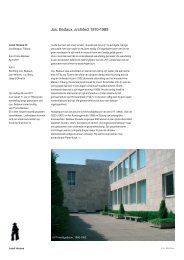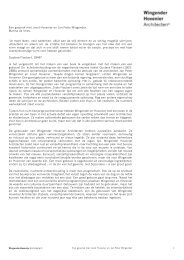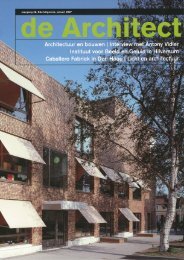Berlin 2009 - Wingender Hovenier Architecten
Berlin 2009 - Wingender Hovenier Architecten
Berlin 2009 - Wingender Hovenier Architecten
Sie wollen auch ein ePaper? Erhöhen Sie die Reichweite Ihrer Titel.
YUMPU macht aus Druck-PDFs automatisch weboptimierte ePaper, die Google liebt.
Holocaust-Mahnmal, <strong>Berlin</strong>, 1998-2005<br />
Peter Eisenman<br />
Although the memorial is still the<br />
subject of political and legal squabbles,<br />
the main idea of the design (in which<br />
Richard Serra was also involved) has<br />
remained. It is intended to convey a<br />
special spatial experience above and<br />
beyond hierarchically organised space.<br />
Today, space is characterised by a<br />
transition - from the production of<br />
objects in space to the production of<br />
space itself. As a product factor, space<br />
is defined in controlled, hierarchical,<br />
political and economic terms - with a<br />
tendency towards reduction to surface<br />
textures - with space itself as<br />
emptiness, reduced to a “medium that<br />
is waiting to be colonised” (Henri<br />
Lefebvre). The Holocaust Memorial is<br />
intended to reactivate spatial<br />
experiences, particularly physical<br />
emotions which can be aroused by<br />
spatial means. The narrow, uniformly<br />
arranged tall stone stele only seem to<br />
form a homogeneous spatial structure.<br />
As soon as it is entered, the apparent<br />
transparency of strict organisation<br />
mutates into a threatening, oppressive<br />
lack of orientation. This experience is<br />
not only metaphorical, it is also an<br />
expression of contradictory spatial<br />
reality.





